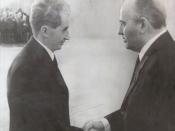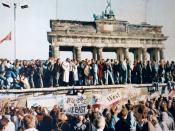At the end of World War II Germany and the City of Berlin were divided into four sectors. The largest sector of East Germany and East Berlin were controlled by the Soviet Union. The United States, Britain and France all controlled a portion in West Germany and West Berlin. The Potsdam Conference in the summer of 1945 was a meeting between the leaders of the victorious allies (Truman, Stalin, and Churchill) whose primary goals included the establishment of post-war order, peace treaty issues, and planning a response to the effects of war. At this conference the allied powers agreed that Germany would one day be reunited. This setup was intended for the Principle Allies to rebuild Berlin's war damaged infrastructure. Berlin was significantly damaged by the allied bombing raids at the climax of the war. Shortly after 1949, the Allie sectors belonging to the United States, Great Britain, and France were once again under German jurisdiction.
The Soviet Union however held sovereignty over East Germany. To deter mass immigration of East Germans to the west, Soviet Premier Nikita Khrushchev closed the border (1961) between East and West Berlin. In June, 1961 the Soviet press of East Berlin announced that 45,000 recruits had volunteered to join the East German Peoples Police and border guards. These recruits were trained in basic civil engineering and on August 13 construction began.
The wall went through four distinct phases. In its earliest stages the wall was not even a wall. Rather a system of concrete cylinders interconnected with barbed wire. This provided moderate containment, however determined East Berliners were still able to escape west. By 1975 the wall was in its final form; consisting of two reinforced concrete barriers separated by a 100 yard dead man zone. This dead man zone, otherwise know as the...


